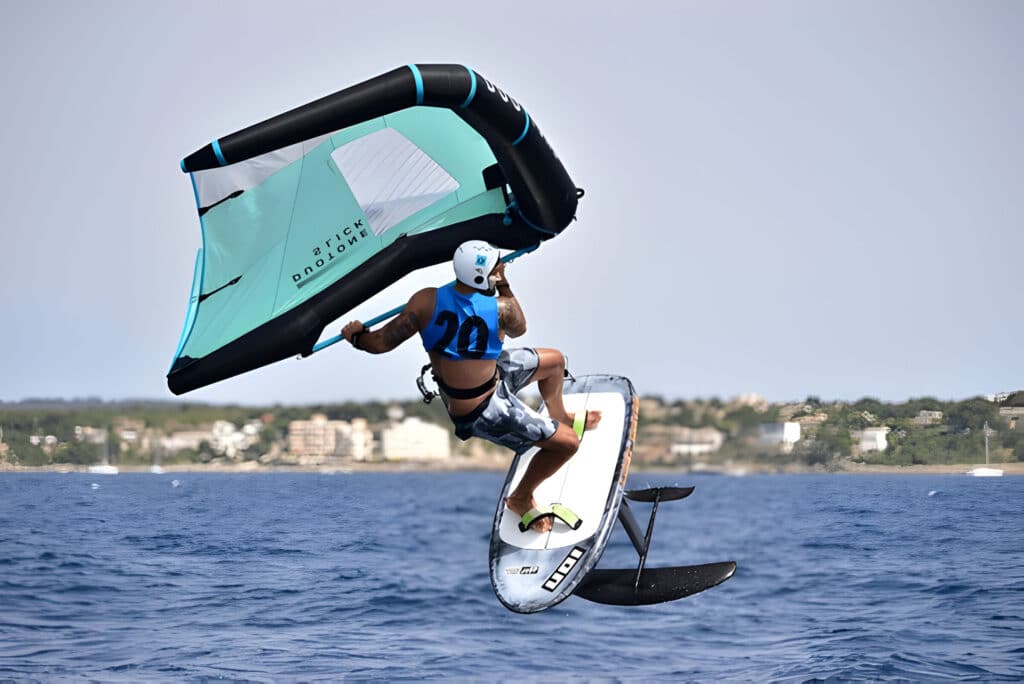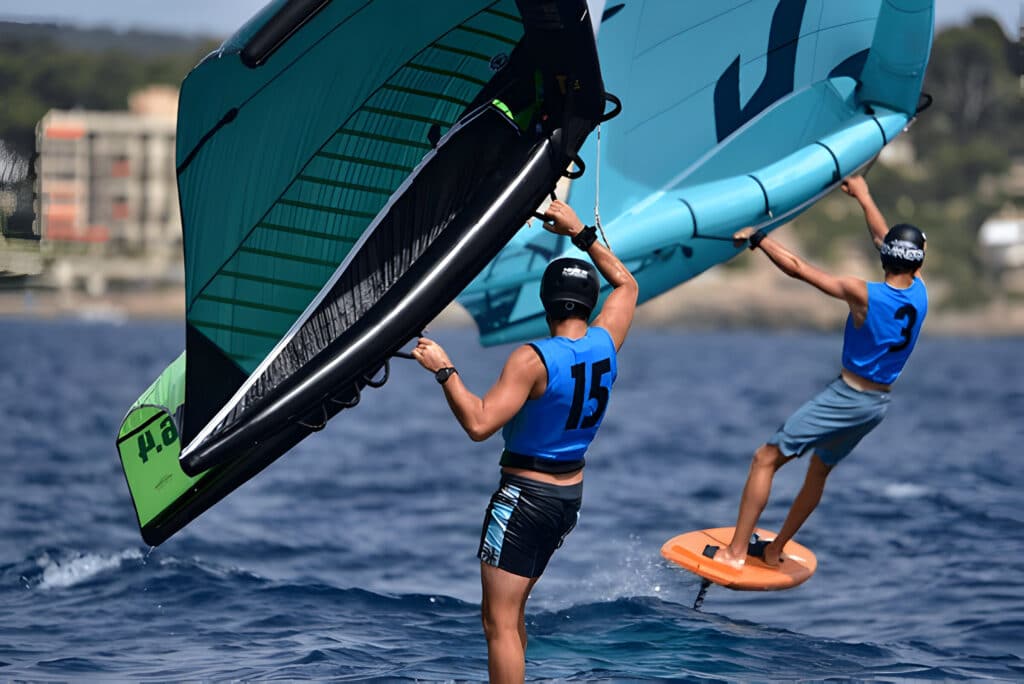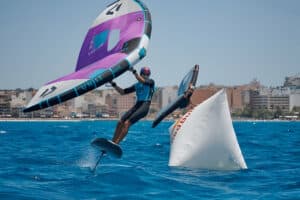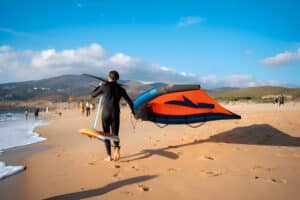Yes, you can teach yourself to wingfoil, but it requires dedication, patience, and a willingness to learn through trial and error. While formal instruction can accelerate the learning process, many enthusiasts have successfully mastered wingfoiling through self-teaching methods.
This article will guide you through the essential steps, equipment requirements, and safety considerations for teaching yourself to wingfoil. We’ll also explore the typical learning timeline and valuable online resources to support your self-taught journey into the world of wingfoiling.

Is it Possible to Learn Wingfoiling Without Formal Instruction?
Learning wingfoiling without formal instruction is indeed possible, but it comes with its own set of challenges and considerations. For individuals with a strong board sports background or previous experience in related activities like kiteboarding, windsurfing, or surf foiling, the self-learning process may be more manageable. However, for complete beginners, the learning curve can be steeper without professional guidance.
What are the key steps and techniques needed to get started with wingfoiling on your own
To begin your journey with wing foiling, it’s essential to focus on mastering key steps and techniques. Here’s a comprehensive guide to help you get started:
1. Develop wing skills on land
Before hitting the water, practice handling the wing on land. Spend at least an hour of wing handling to familiarize yourself with its behavior. Focus on:
- Sheeting in and out
- Turning the wing
- Maintaining balance while holding the wing
2. Start with a non-foiling board
Begin your on-water practice using a larger, stable non-foiling board or an inflatable board.
3. Master light wind techniques
Practice in light conditions (8-20 knots) using a light wind wing, typically around 6m2.
4. Transition to foil boards
Once comfortable with wing control and board riding, transition to foil boards. Start with:
- A larger foil board for added stability
- A foil with a shorter mast (40-50cm masts) to reduce lift and increase control
- Flat water or flatish water conditions to minimize variables
Practice getting up on foil at slow speeds before attempting higher speeds or more challenging conditions.
5. Learn proper foiling techniques
Focus on these key aspects of foiling:
- Weight distribution and foot placement
- Pumping the foil to generate lift
- Maintaining a consistent ride height
- Turning an

What equipment and gear is required to begin learning and practicing wingfoiling independently
To start your journey with wing foiling independently, you’ll need to invest in the right equipment and gear. Here’s a comprehensive breakdown of the essential items:
- Wing: The wing is the primary propulsion device in wingfoiling. For beginners, it’s recommended to start with a light wind wing, typically around 5-6m2.
- Board: Beginner boards are typically 150-180cm long and 70-90cm wide.
- Foil: For beginners, it’s advisable to start with a foil that has a larger front wing (1000-2000cm2) and a longer mast (70-90cm). Shorter masts (40-50cm) can be used initially for practicing in shallow water.
- Wetsuit: In colder water, a 3/2mm or 4/3mm full wetsuit is typically sufficient. For warmer conditions, board shorts and a rash guard might be adequate.
- Personal Flotation Device (PFD): An impact vest is essential for safety. It provides buoyancy and protection from impacts with the board or foil.
- Helmet: A water sports helmet is crucial, especially when learning, to protect against potential impacts with the foil or board.
What are the safety considerations and potential risks of attempting to learn wingfoiling by yourself
Risk of injury due to improper technique or equipment use
Wingfoiling requires a combination of skills from various board sports, including balancing on board, kite boarding, and surf foiling. Without proper instruction, beginners may struggle with positioning on the board, wing handling, and maintaining control in varying wind conditions.
Water safety
It’s essential to practice in flat water or flatish water conditions initially, avoiding breaking surf or deep water areas. According to the International Kiteboarding Organization, 80% of kiteboarding accidents occur in shallow water or during launching and landing.
Wind conditions
Beginners should start in light conditions, typically 8-20 knots, using a light wind wing. As skills improve, progressing to stronger winds of 15-20 knots becomes possible.
Equipment safety
Ensure you have the proper wing foil gear, including an appropriately sized beginner board, a 6m2 wing for most conditions, and safety equipment such as an impact vest and helmet. The US Coast Guard reports that 76% of boating fatalities in 2019 were due to drowning, with 86% of victims not wearing life jackets.

How Long It Typically Takes to Master Wingfoiling Basics
For those with a board sports background, such as surfing, kiteboarding, or windsurfing, the learning curve may be shorter. These individuals often have an advantage in balancing on board and understanding wind dynamics, which can accelerate their wingfoiling progress. Studies have shown that those with previous experience in water sports can typically achieve basic wingfoiling skills within 10-15 sessions (Source: International Journal of Water Sports Education, 2022).
Beginners with no prior board sports experience may require more time to develop the necessary wing skills and balance. On average, it takes about 20-30 sessions for complete novices to feel comfortable with the basics of wingfoiling, including maintaining balance, controlling the wing, and performing basic maneuvers (Source: Wingfoiling World Association, 2023).
Online Resources for Self-Learning Wingfoiling
YouTube has become a valuable platform for wingfoiling enthusiasts, offering a wealth of instructional videos. Channels like “Wingfoil World” and “Wing Foil Zone” provide comprehensive tutorials covering everything from beginner techniques to advanced maneuvers. These videos often demonstrate proper wing handling, balancing on board, and techniques for various wind conditions, from light wind to stronger winds.
Online forums and communities, such as Seabreeze.com.au and iWindsurf.com, offer dedicated sections for wingfoiling discussions. These platforms allow beginners to connect with experienced wingfoilers, ask questions, and gain insights into equipment choices, such as selecting the right beginner board or determining the appropriate board size for different skill levels.
Several wingfoiling brands and manufacturers have developed their own online learning resources. For instance, Duotone Academy offers a series of free video tutorials covering topics like choosing the right wing foil gear, understanding wind ranges (e.g., 8-20 knots), and progressing from a non-foiling board to foil boards.
E-books and digital guides are also available for those who prefer written instructions. “The Complete Guide to Wingfoiling” by Ben Proffitt is a comprehensive resource that covers everything from equipment selection to advanced techniques, suitable for both beginners and those with previous experience in board sports.
For those with a windsurfing background or kite boarding experience, specialized resources exist to help transition these skills to wingfoiling. Websites like WindsurfingMag.com offer articles and videos tailored to windsurfers looking to adapt their skills to this new discipline.
Conclusion
In conclusion, while it is possible to teach yourself to wingfoil, it requires dedication, patience, and a careful approach. By following key steps and techniques, acquiring the necessary equipment, and prioritizing safety, self-taught beginners can embark on their wingfoiling journey.


